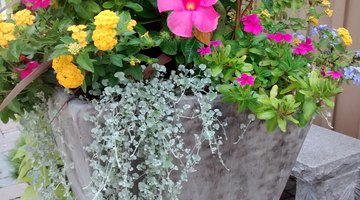What to Put in the Bottom of a Large Planter
Potted plants are a way to bring nature indoors or to organize an outdoor garden. Extra-large containers are decorative, and many larger plants with heavy trunks or expansive root systems require larger planters to provide adequate support.

Fillers at the bottoms of large planters are used for promoting proper drainage and adjusting the weight at the bottom of the pot, whether too heavy or too light.
Filler Considerations

Before you line the bottom of your planter with a filler material, consider the needs of your plant. If fillers block the container's drainage holes, your plant won't drain properly. You may end up drowning your plant or causing root rot. If you plan on moving your container regularly, filler can help reduce its weight. Stick to light-weight fillers to replace heavier soil materials. If you want to make your plant less prone to tipping, make it bottom heavy. Opt for filler materials that are heavier than the top soil.
Natural Fillers

All-natural or organic materials are natural filler options for lining the bottom of your planters when you want to avoid using synthetic materials. The same bark mulch that lines your outdoor shrubs is a suitable option for filling planter bottoms. Mulch is natural and won't interfere with the regular drainage of your soil. If you have a yard full of evergreen trees, collect a bucket of pine cones for a simple, effective option for naturally filling the bottom of your planters.
Recycled Materials

Several items suitable for reuse as planter fillers may already be in your home. Packing peanuts are a popular option for filling large planters. Packing peanuts are nearly weightless and provide ample draining space for your soil. To avoid hassle during replanting, keep the peanuts in a mesh bag so they don't mix in with your soil. If you regularly recycle plastic bottles, leave some whole or cut them into thirds to line the bottom of your planters without adding much weight to the containers.
Weighted Fillers

If you are worried about your large planters tipping, weighting the bottom of your containers is a way to avoid messy spills. Rocks or pebbles are a natural option for the bottom of large planters. They add weight without interfering with drainage or introducing unnatural materials into the mix. Old bricks broken into large chunks are also an option for weighing down the bottom of containers and keeping soil drainage effective.
The Drip Cap
- Potted plants are a way to bring nature indoors or to organize an outdoor garden.
- You may end up drowning your plant or causing root rot.
- Stick to light-weight fillers to replace heavier soil materials.
- To avoid hassle during replanting, keep the peanuts in a mesh bag so they don't mix in with your soil.
- Rocks or pebbles are a natural option for the bottom of large planters.
References
- Container Gardening: 250 Design Ideas & Step-By-Step Techniques; From the Editors and Contributors of Fine Gardening
- Rental Decorating: Container Gardening
- Birds & Blooms: Got Large Pots? Use Plastic Containers to Fill Extra Space
Writer Bio
Hannah Wahlig began writing and editing professionally in 2001. Her experience includes copy for newspapers, journals and magazines, as well as book editing. She is also a certified lactation counselor. She holds a Bachelor of Arts in English from Mount Holyoke College, and Master's degrees in education and community psychology from the University of Massachusetts.
Photo Credits
- Jeanne Studio/Demand Media
- Jeanne Studio/Demand Media
- Jeanne Studio/Demand Media
- Jeanne Studio/Demand Media
- Jeanne Studio/Demand Media
- Jeanne Studio/Demand Media
More Articles



